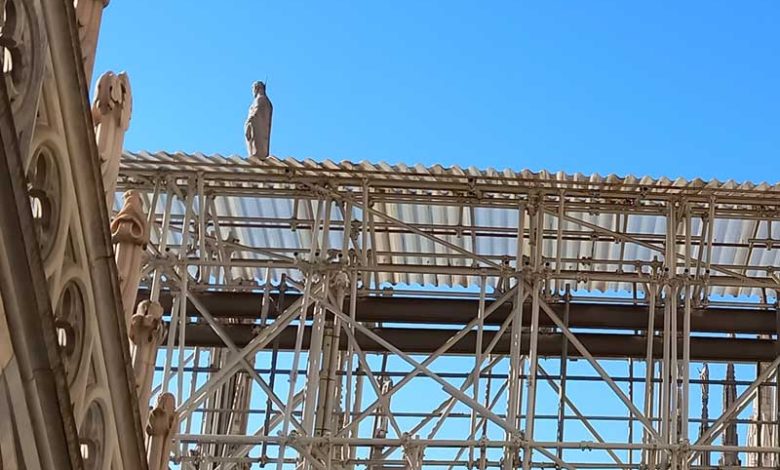Case Study: Scaffolding in the Restoration of the Château Frontenac, Quebec City, Canada

The Château Frontenac, a historic jewel overlooking the St. Lawrence River in Quebec City, Canada, stands as an iconic symbol of grandeur and elegance. This case study delves into the pivotal role of scaffolding in the restoration and preservation of the Château Frontenac, highlighting the unique challenges faced, innovative solutions implemented, and the successful outcomes achieved through meticulous planning and execution.
Introduction to the Château Frontenac
Perched majestically atop Cap Diamant, the Château Frontenac is not only a luxurious hotel but also a UNESCO World Heritage site and an emblem of Quebec City’s rich architectural heritage. Designed by renowned architect Bruce Price and opened in 1893, the Château Frontenac boasts a distinctive castle-like appearance with turrets, copper roofs, and intricate stonework that blend seamlessly with the city’s historic skyline.
Project Overview: Facade Restoration and MaintenanceChallenges
Over time, exposure to Quebec City’s climate, including harsh winters and humid summers, had taken a toll on the Château Frontenac’s exterior facade. The restoration project aimed to address several critical challenges:
- Preservation of Historical Integrity: Ensuring that the restoration efforts maintained the original architectural design and aesthetic charm of the Château Frontenac.
- Structural Rehabilitation: Repairing and reinforcing deteriorating masonry, including limestone walls and decorative elements.
- Environmental Sensitivity: Minimizing disruption to hotel operations and ensuring the safety of guests and staff during restoration activities.
Scaffolding Solution
To facilitate the comprehensive restoration and maintenance of the Château Frontenac’s facade, a sophisticated scaffolding system was meticulously planned and executed:
- Custom Design: Engineers and scaffolding experts collaborated to design a tailored scaffolding system that could safely access all areas requiring restoration, including the intricate details of the turrets and steep roofs.
- Adaptability: The scaffolding system was designed to conform to the unique contours and architectural features of the Château Frontenac, ensuring minimal impact on its historical integrity.
- Safety Measures: Robust safety features, such as guardrails, toe boards, and non-slip platforms, were integrated into the scaffolding design to protect workers and prevent debris from falling onto the busy streets below.
- Logistical Planning: Detailed logistical planning ensured efficient material handling and minimized disruption to hotel guests and nearby businesses throughout the restoration process.
Implementation and Execution
The scaffolding installation and restoration process at the Château Frontenac followed a meticulous timeline and methodology:
- Site Preparation: Clearing and securing the surrounding area to accommodate scaffolding assembly and ensure public safety.
- Scaffolding Assembly: Erecting the scaffolding structure around the entire perimeter of the Château Frontenac, meticulously aligning it with the intricate architectural features of the facade.
- Restoration Work: Skilled craftsmen and restoration specialists accessed the scaffolding platforms to meticulously repair and clean the facade’s limestone walls, decorative elements, and roofing.
- Quality Assurance: Regular inspections and quality checks were conducted throughout the restoration project to ensure adherence to preservation standards and safety protocols.
Benefits and Outcomes1. Preservation of Architectural Heritage
The scaffolding system enabled precise access to delicate architectural features, facilitating the preservation and restoration of the Château Frontenac’s historic charm and cultural significance.
2. Enhanced Safety and Efficiency
By providing stable and secure platforms, the scaffolding system ensured the safety of workers and accelerated restoration activities, leading to efficient project completion within the scheduled timeframe.
3. Community Impact
The successful restoration of the Château Frontenac’s facade contributed to the revitalization of Quebec City’s historic district, enhancing tourism and preserving a cherished landmark for future generations to admire and enjoy.
Conclusion
The restoration of the Château Frontenac’s facade exemplifies the indispensable role of scaffolding in preserving and enhancing historic buildings. Through meticulous planning, innovative solutions, and adherence to safety standards, scaffolding facilitated the successful completion of this prestigious project while safeguarding the architectural legacy of one of Canada’s most beloved landmarks. As Quebec City continues to celebrate its cultural heritage, the restoration of the Château Frontenac stands as a testament to the enduring value of historical preservation and the crucial role of scaffolding in achieving these preservation goals with efficiency and excellence.





